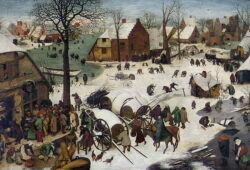N.C. Wyeth’s Mastery: A Journey Through Time in Paintings
 Posted On
Posted On
N.C. Wyeth, one of America’s most celebrated artists of the 20th century, left an indelible mark on the world of illustration and fine art. Born in 1882, Newell Convers Wyeth, better known as N.C. Wyeth, carved his niche with a brush and canvas, creating timeless works that continue to captivate audiences to this day. His paintings are a testament to his immense talent and his ability to transport viewers to distant places and eras through his art.
Wyeth’s career as an illustrator began in the early 20th century when he gained recognition for his striking illustrations in classic novels and magazines. One of his most famous works, “Treasure Island” (1911), was an immediate success and established his reputation as a masterful storyteller through art. His vivid and dramatic illustrations breathed life into Robert Louis Stevenson’s beloved characters, making the adventure of Jim Hawkins and Long John Silver come alive for readers of all ages.
Wyeth’s skill in capturing the essence of adventure and exploration is further exemplified in his series of illustrations for the works of James Fenimore Cooper. His depictions of the frontier landscape and characters from novels like “The Last of the Mohicans” (1919) transported readers to the rugged landscapes of early America. His paintings allowed readers to experience the thrilling narratives as if they were present in those tumultuous times.
While his illustrations for literature garnered him widespread acclaim, N.C. Wyeth’s transition to fine art marked a significant chapter in his career. He moved away from the confines of commissioned work and began to create paintings that were a testament to his artistic vision. His fascination with historical themes and his penchant for storytelling continued to shine through in his fine art.
One of Wyeth’s most iconic fine art paintings is “The Giant” (1923), which depicts a massive figure towering over a lush landscape. The sense of awe and wonder in this piece is palpable, capturing the imagination of anyone who beholds it. It serves as a testament to Wyeth’s ability to evoke emotion and wonder through his brushwork.
Wyeth’s landscapes are equally impressive, showcasing his mastery of color and light. “Island Funeral” (1939) is a prime example of his ability to convey the mood and atmosphere of a place through paint. The serene yet haunting depiction of a funeral on an isolated island is a visual symphony that resonates with viewers, inviting them to contemplate the scene’s deeper meaning.
Wyeth’s legacy extends beyond his own work. He passed his artistic gifts to his talented son, Andrew Wyeth, who would go on to become one of America’s most renowned artists as well. Andrew’s career was profoundly influenced by his father’s artistic guidance and vision.
In conclusion, N.C. Wyeth’s paintings are a testament to his enduring legacy as an artist who bridged the gap between illustration and fine art. His ability to breathe life into the stories of classic literature and to transport viewers to different times and places through his work is a testament to his genius. His contributions to both illustration and fine art continue to inspire and captivate art enthusiasts and storytellers alike. N.C. Wyeth’s paintings will forever stand as a testament to the power of art to transport us to worlds of wonder and imagination.



